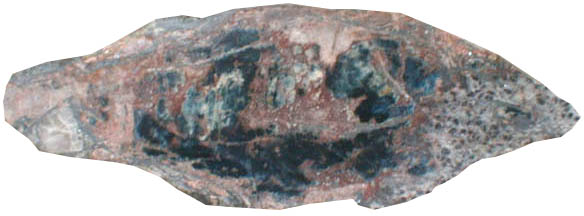
Phosphate minerals
The most common phosphate mineral at Västanå iron mine is manganoan fluorapatite. The apatite occurs in two forms, one pink and one green variety. The green apatite seems to occur mostly together with pyrophyllite in veins in the hematite ore, while the pink apatite seems to be more associated with the hematite ore and the other phosphate minerals. Nice apatite crystals has been found in kaolinite and pyrophyllite specimens. Most of the rare phosphates occurs in so called phosphate lenses, that is nodules composed by different phosphates in a more or less zonated manner. The lenses is normally surrounded by micaceous hematite ore or more uncommon quartz. Lazulite often occurs in the boundaries between the lens and the surroundings, sometimes with a layer of augelite closely towards the center of the lens. In the middle minerals such as berlinite and augelite, attakolite etc occurs. Attakolite, fluorapatite and lazulite all occurs both associated with the lenses and as a free (non lensassociated) mineral.

A good example of an phosphate lens, the outher shape correspond to the hematite boundary. The dark dots in the micaceos hematite is the local variety of andalusite once called "Westanite".
| Attakolite (Ca, Sr)Mn(Al,Fe)4(HSiO4)(PO4)3(OH)4 Västanå is the only known locality for attakolite, which was described by Blomstrand in 1868. This is one of the phosphates that occurs both inside and outside of the so called phosphate-lenses. The name attakolite comes from the greek word of the color, salmon red. View more attakolite specimens! |
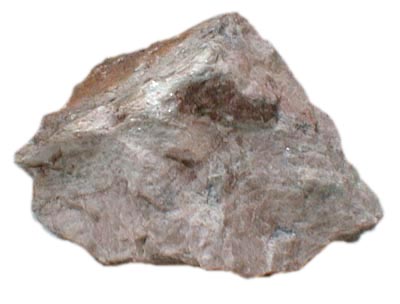 |
|
Augelite Al2(PO4)(OH)3 Västanå is the typelocality for augelite, and it was described by Blomstrand in 1868. Occurs in the phosphate lenses together with lazulite, trolleite, berlinite etc. The color is whitish to reddish. A good sign for recognition is it´s highly reflective cleveage surfaces. Probably some small augelite crystals has been found. View more augelite pictures! |
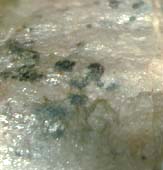 |
|
Bearthite Ca2Al(PO4)2OH Occurs together with trolleite and cyanite in a yellow mixture previously named kirrolite. See Chopin et al. (1993) under references. |
|
|
Berlinite AlPO4 Västanå is the typelocality for berlinite, and it was described by Blomstrand in 1868. Occurs as tiny veins inside the phosphate lenses. Isostructural with quartz and looks exactly the same. The only way to see the difference is by analyse. Berlinite occurs (only) in the phosphate lenses while quartz seems not to be there. The name berlinite comes from the swedish chemist Nils Johan Berli´n (1812-91) professor in Lund. View more berlinite pictures! |
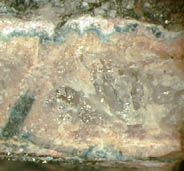 |
|
Bjarebyite (Ba, Sr)(Mn, Fe, Mg)2(Al, Fe)2(PO4)3(OH)3 Was described from Västanå iron mine by R. Thomasson in 1983 in his M.Sc. thesis. The mineral is olive green and occurs inside the phosphate lenses. |
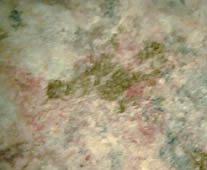 |
|
Childrenite FeAl(PO4)(OH)2 H2O Childrenite and millisite from Västanå iron mine was described in GFF volume 124 (1994) p. 92. Occurs as really small crystals together with millisite in phosphate lenses. |
 |
| Millisite NaCa(Al, Fe)6(PO4)4(OH)9 3H2O Occurs as really small spherules together with childrenite. |
 |
| Lazulite (Mg, Fe)Al2(PO4)2(OH)2 Occurs both in the phosphate lenses and as free masses with apatite, cyanite and quartz in the ore. View more lazulite pictures! |
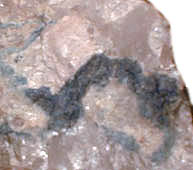 |
|
Trolleite Al4(PO4)3(OH)3 Västanå is the typelocality for trolleite, and it was described by Blomstrand in 1868. The color is green and it occurs together with the other lens phosphate minerals. The mineral is named after count Hans Gabriel Trolle-Wachtmeister (1782-1871). |
|
|
Svanbergite (Sr, Ca, Pb?) Al3(PO4)(SO4)(OH)6 Occurs as reddish brownish masses and crystals in quartz and in the ore. Sometimes together with nacrite or muscovite. It´s one of the few minerals that sometimes occurs as nice crystals in Västanå. |
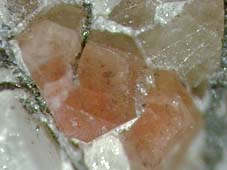 |
Hurlbutite CaBe2(PO4)2 Hurlbutite from Västanå iron mine was described in GFF volume 124 (2002), pp. 41-43. Currently only one specimen with hurlbutite has been found in Västanå. It was collected in the summer 1997 by Daniel and Lennart Svensson. It is now divided into two pieces, one located in Daniel Svensson´s mineral collection and the other one is located in the mineral collection at the Center for Chemistry and Chemical Engineering in Lund. It occurs sorrunded by manganese apatite in micaceous hematite ore. The color is yellowish to whitish, and it appears to be very porous. |
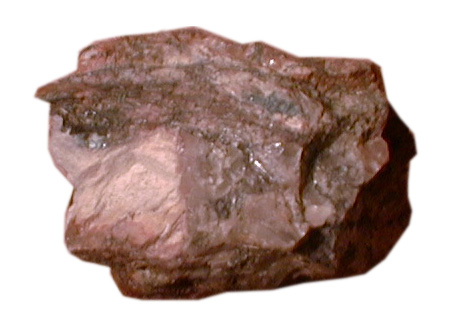 |
Fluorapatite (Ca, Mn)5(PO4)3F A pinkish apatite occurs in the hematite ore sometimes together with other phosphates, while a more greenish apatite, sometimes with well defined crystal shape, occurs together with pyrophyllite. Click here for more apatite pictures |
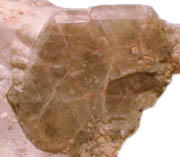 |
Silicate minerals
| Andalusite Al2SiO5 | |
|
Cyanite Al2SiO5 Occurs sporadically in the hematite ore as small elongated crystals with a flat surface, sometimes the color is a bit blue. |
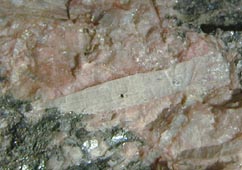 |
Muscovite KAl2(Si3Al)O10(OH, F)2 Occurs in the hematite ore, sometimes together with svanbergite, more well crystalized with quartz and as granular masses. |
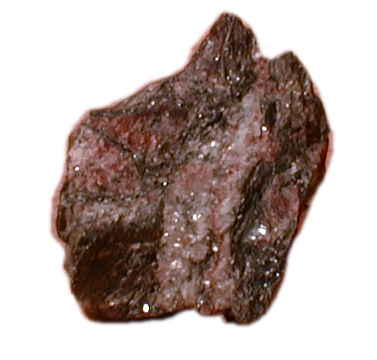 |
Nacrite (kaolinite) Al2Si2O5(OH)4 Occurs together with pyrophyllite, sometimes with small inclusions of svanbergite crystals. |
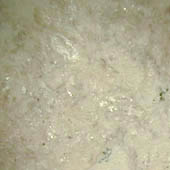 |
|
Pyrophyllite Al2Si4O10(OH)2 Occurs as massive aggregates in the micacous hematite ore, sometimes together with quartz and green apatite crystals. |
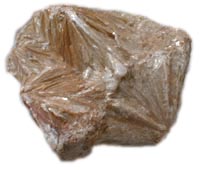 |
Quartz SiO2 |
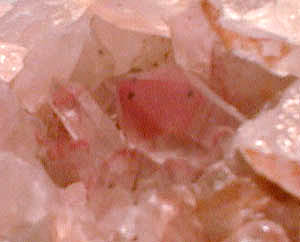 |
Copyright by Daniel Svensson 2002- 2003. If you would like to use some pictures,
please ask me.